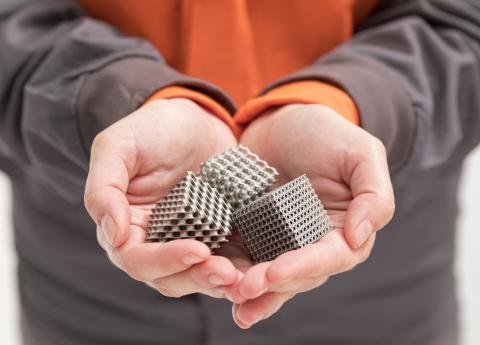White Paper 1: Novel approach to increase LPBF productivity
ArcelorMittal Global Research and Development
White Paper 1: Novel approach to increase LPBF productivity
ArcelorMittal Global Research and Development
May 2023
Introduction
Laser Powder Bed Fusion (LPBF) is the most widely used additive manufacturing technology for producing metal parts, layer-by-layer. Given the significant capex involved in installing an LPBF machine, increasing the productivity of the process is a critical factor to significantly reducing the production costs of the additively manufactured parts.
A common approach to try to define the most productive printing conditions for a given material is to print density cubes under different conditions and to create maps of density versus volumetric energy density (VED). Sufficient density is taken as an indicator of quality while the lowest VED is expected to give the fastest build rate.
Motivation
Since 2018, ArcelorMittal R&D has been exploring the potential of additive manufacturing to optimise the production of spare parts, often critical, and consumables used in ArcelorMittal’s steelmaking operations. These parts were originally designed from a conventional manufacturing perspective, which often resulted in complex assemblies due to the limitations of the processes.
The research approach was defined along two main action lines. The first was to replace or repair parts where the lead time and cost of additive manufacturing were competitive with traditional production methods. The second was to go deeper into application areas and to identify (sub-)assemblies which could be re-designed to benefit from some, or all, of the advantages of additive manufacturing, namely part consolidation, light-weighting, improved performance, increased functionality and material savings. Initially, few applications could be identified where LPBF could be competitive in size and cost to alternative supply options.
Subsequently, a dedicated research line was started to increase the productivity and quality of LPBF by adjusting the process parameters and printing strategies. The goal was to test the limits of LPBF and identify whether sufficient cost improvement could be made to justify the technology’s use in a wider range of applications.
Given that processing parameters change with the material being processed, the work covered those steel grades that are most commonly used in additive manufacturing, namely 316L, 17-4PH, M300 and H13. While the first approach was to use the VED/density analysis, it soon became clear that this would not lead to sufficient productivity gains. Also, it did not address issues such as reducing residual stresses, improving surface roughness, or enhancing mechanical properties.
Other factors, but especially the printing strategy, were found to be influential in achieving the maximum productivity in terms of build rate in cubic centimetres per hour. Based on these findings, a new methodology for LPBF process optimisation is proposed, which is the one now being used by ArcelorMittal to assess parts for serial production.

